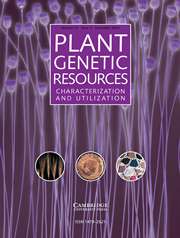No CrossRef data available.
Article contents
Insights into the genetic divergence in Asiatic cotton (Gossypium arboreum L.) germplasm for fibre-quality traits
Published online by Cambridge University Press: 09 October 2024
Abstract
Asiatic cotton (Gossypium arboreum L.) has evolved in the Indian subcontinent and is known for its adaptability to low-input management conditions. In the present study, 300 diverse G. arboreum lines, including 100 Nandyal arboreum breeding lines (NAB), 132 Arboreum germplasm collections (AGC) and 68 long-linted arboreum genotypes (LLA), were evaluated for fibre quality to assess the diversity among them and to identify promising genotypes with desirable fibre traits. Significant variations were observed among the genotypes for the studied fibre-quality traits. Principal component analysis showed that the traits micronaire (Mic) and elongation percentage (E%) followed by upper half mean length (UHML) and bundle tenacity (tenacity) were the most significant contributors to variation. Cluster analysis based on the Euclidian distance method showed 16 clusters among 300 G. arboreum genotypes. The genotypes in cluster 4 have desirable UHML, tenacity and UI (uniformity index) traits, and cluster 12 has Mic and E% traits. Furthermore, the number of genotypes with desirable fibre-quality traits was found to be higher in the AGC group than in the LLA and NAB groups. The trait tenacity followed by the UHML showed relatively higher Shannon–Weiner diversity index values across different genotypic groups. Based on the superior performance, the genotypes PA 847, PA 809, PA 837, PA 863, NDLA 3147-2, NDLA 2974 and NDLA 3081 were found to be having desirable fibre traits. The identified promising genotypes are valuable genetic resources for improving fibre quality in G. arboreum cotton.
- Type
- Research Article
- Information
- Copyright
- Copyright © The Author(s), 2024. Published by Cambridge University Press on behalf of National Institute of Agricultural Botany


